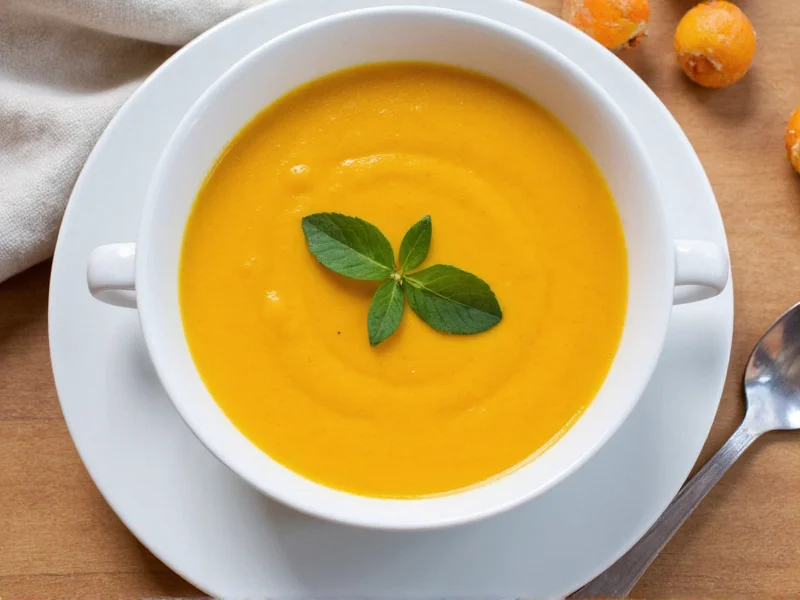Understanding Canned Pumpkin Soup Composition
Many home cooks confuse pumpkin puree with pumpkin pie filling, leading to disappointing results. True canned pumpkin soup uses 100% pure pumpkin puree as its base, typically combined with vegetable or chicken broth, onions, and aromatic spices. Premium varieties maintain a smooth texture without starch thickeners or artificial stabilizers.
When evaluating healthy canned pumpkin soup options, examine the nutrition label for:
| Ingredient to Check | Ideal Amount | Red Flags |
|---|---|---|
| Sodium content | Under 400mg per serving | Over 700mg per serving |
| Sugar | 0-2g per serving | 5g+ per serving |
| Thickeners | Natural options only | Cornstarch, flour |
| Preservatives | Minimal | Sodium benzoate, sulfites |
Historical Evolution of Canned Pumpkin Soup
Understanding the development timeline reveals how industrial advancements shaped modern convenience. Key transitions include:
- 1809: Nicolas Appert's canning method enabled long-term preservation of seasonal produce, though early techniques used glass containers with inconsistent results. [Source: National Center for Home Food Preservation]
- 1929: Libby's introduced the first commercially viable canned pumpkin puree using a specialized strain (Libby's Select Dickinson) that maintained texture during processing, replacing inconsistent homemade preparations. [Source: Libby's Company History]
- 1950s: Ready-to-serve pumpkin soup emerged as convenience foods expanded, with standardized recipes ensuring consistent flavor profiles across seasons—a critical factor for commercial kitchens today. [Source: Smithsonian National Museum of American History]
Five Professional Techniques to Elevate Canned Pumpkin Soup
Transform basic canned pumpkin soup recipes from ordinary to exceptional with these chef-approved methods:
1. Depth Enhancement Through Layering
Sauté aromatics like shallots, garlic, and fresh ginger in olive oil before adding the canned soup. This builds flavor complexity that simple reheating cannot achieve. For richer depth, incorporate a tablespoon of tomato paste during sautéing.
2. Texture Refinement Methods
Many commercial varieties contain starch thickeners that create an artificial mouthfeel. Improve texture by:
- Simmering uncovered for 10-15 minutes to reduce and concentrate flavors
- Adding a splash of coconut milk for creaminess without heaviness
- Blending with roasted sweet potatoes for natural thickness
3. Balanced Seasoning Approach
Basic spicing up canned pumpkin soup requires more than just salt. Create harmony with:
- Acidity: A squeeze of fresh lemon or apple cider vinegar brightens flavors
- Umami: A dash of soy sauce or miso paste enhances savory notes
- Warmth: Freshly grated nutmeg surpasses pre-ground versions
Contextual Limitations and Best Use Cases
Canned pumpkin soup excels in specific scenarios but has defined constraints where alternatives are preferable:
- Sodium-Sensitive Diets: Even "reduced-sodium" versions average 350mg per serving—23% of the American Heart Association's ideal daily limit (1,500mg) for hypertension management. Fresh preparation with unsalted broth is essential for strict cardiac diets. [Source: American Heart Association]
- Infant Nutrition: Not suitable for children under 12 months due to sodium content exceeding pediatric guidelines. The American Academy of Pediatrics explicitly advises against added salt in infant foods. [Source: American Academy of Pediatrics]
- Flavor-Pure Applications: When recipes require unadulterated pumpkin (e.g., baking), plain puree is mandatory. Canned soup's broth and seasonings disrupt Maillard reactions in baked goods, altering texture and browning.
Creative Applications Beyond Traditional Serving
Expand your culinary repertoire with these innovative uses for canned pumpkin soup:
Savory Breakfast Transformation
Replace half the liquid in your pancake or waffle batter with warmed canned pumpkin soup. The natural sweetness and earthy notes create restaurant-quality breakfast dishes with minimal effort. Top with toasted pecans and a light maple drizzle.
Unexpected Sauce Base
Thin canned pumpkin soup with additional broth to create a velvety pasta sauce. Toss with roasted vegetables and whole grain pasta for a complete meal. The pumpkin's natural sugars caramelize beautifully when reduced, creating complex flavor notes.
Optimal Storage Practices for Maximum Freshness
Proper handling extends the shelf life of opened canned pumpkin soup storage tips containers:
- Transfer to airtight glass containers immediately after opening
- Refrigerate within two hours of opening
- Consume within 3-4 days for best quality
- Freeze in portion-sized containers for up to 3 months
When freezing, leave 1-inch headspace for expansion. Thaw overnight in the refrigerator rather than at room temperature to maintain texture integrity. Avoid refreezing previously frozen soup.
Seasonal Pairing Recommendations
Elevate your dining experience with these complementary pairings for canned pumpkin soup recipes:
Perfect Bread Accompaniments
Choose crusty breads with contrasting textures:
- Seeded sourdough for nutty complexity
- Warm naan brushed with garlic oil
- Crispy baguette slices topped with whipped feta
Ideal Beverage Partners
Balance the soup's earthy sweetness with:
- Medium-bodied red wines like Pinot Noir
- Sparkling apple cider with cinnamon
- Chai tea with reduced sweetness











 浙公网安备
33010002000092号
浙公网安备
33010002000092号 浙B2-20120091-4
浙B2-20120091-4